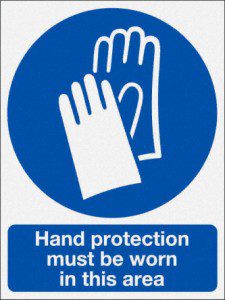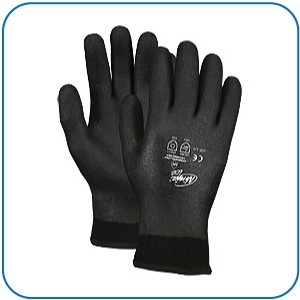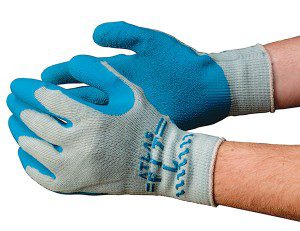by Alex Marks Posted: July 1, 2006
 A glove audit can reduce injuries and costs and consolidate glove usage
A glove audit can reduce injuries and costs and consolidate glove usage
Why should your company conduct a glove audit, and what is involved to execute such an audit?
There are various reasons why a glove audit is necessary. In addition to compliance and due diligence issues, a glove audit can also serve as a means of reducing injuries, lowering costs and consolidating your glove usage. Let’s take a look at what’s involved in a glove audit.
Identify the hazard and who is at risk
First, you must identify the hazard (something with the potential to cause harm) and then identify the risk (the likelihood that harm will occur), as well as who is at risk, e.g., maintenance workers, contractors, cleaners and visitors. When gathering information, check your own employee accident and ill health records, talk to your workers and consult your manufacturers’ instructions and data sheets.
Concentrate on significant hazards, not trivial ones. Some examples of hazards might include chemicals, microbiological agents, electricity, compressed gases, slip/trip hazards and working with sharp objects.
Evaluate the risk
 It may be necessary to implement controls, but you should record your findings and review the assessment. Some questions to ask yourself are: Can you control the risks by trying a less risky operation? Can you prevent the hazard? Will personal protective equipment (PPE) be a solution? Can the hazard be eliminated? Are existing precautions adequate? Would you evaluate the risk as high, medium or low?
It may be necessary to implement controls, but you should record your findings and review the assessment. Some questions to ask yourself are: Can you control the risks by trying a less risky operation? Can you prevent the hazard? Will personal protective equipment (PPE) be a solution? Can the hazard be eliminated? Are existing precautions adequate? Would you evaluate the risk as high, medium or low?
To better understand if your control measures are adequate, you should routinely test them. You should also monitor workplace hazards, implement accident and health surveillance and put emergency measures in place to prepare for the worst scenario.
Record and review your assessment
In order to improve your company’s experience for hand-related injuries, it is necessary to create a benchmark by which to measure improvement. You can begin by recording your findings with written and computer records (general risk assessment form). You could also create a more specific form at the departmental level.
When reviewing your records and your previous assessment, you can now look at such things as specific influences of changes in equipment, substance changes, procedural changes and if you are now in compliance with legislation and standards. The goal is to be better able to review your assessment on a regular basis to reduce near-miss occurrances, accidents and ill health.
Choose the right glove
 Risk assessment will require that you choose the best hand protection product for working with specific hazards. The notes below on various glove coatings will help you to decide what’s best for your particular application. You can also ask manufacturers for their electronic or hard copy selection guides, such as the North Safety Products’ Chemical Resistance Guide and the online ezGuide service.
Risk assessment will require that you choose the best hand protection product for working with specific hazards. The notes below on various glove coatings will help you to decide what’s best for your particular application. You can also ask manufacturers for their electronic or hard copy selection guides, such as the North Safety Products’ Chemical Resistance Guide and the online ezGuide service.
Nitrile
Nitrile gloves are the most effective replacement for natural rubber, vinyl and neoprene. Nitrile offers excellent protection against acids, bases, oils, solvents and esters, grease and animal fats. Nitrile gloves are more resistant to snags, punctures, abrasion and cuts than neoprene or PVC gloves. Nitrile also does not contain latex proteins, which may cause allergic reactions.
Because nitrile gloves are so versatile, they are ideal for use in laboratories, automotive and aircraft parts handling and assembly, solvent plant cleaning, chemical processing, food processing, petroleum refining, dip tank operations, acid etching, painting, graphic arts, battery manufacturing, degreasing, electronics and handling pesticides.
PVC
PVC gloves provide excellent resistance to most fats, oils, acids, caustics and petroleum hydrocarbons. They are resistant to alcohols and glycol ethers, but not aromatics, aldehydes and ketones. In particular, PVC gloves are good for handling such chemicals as: citric acid (10%), cyclohexane, ethylene glycol, formaldehyde, formic acid, glycerine, hydrochloric acid (10%), linseed oil, perchloric acid, potassium hydroxide and tannic acid.
Because PVC gloves have excellent abrasion resistance, they are ideal for use in petrochemical industry, construction and oily or greasy applications. Insulated high visibility orange PVC gloves are also available and are ideal for the fishing industry, cold storage, signaling to crane operators, winter road work and winter deliveries of heating fuel.
Butyl
Butyl gloves exhibit the highest permeation resistance to gas or water vapors of any glove compound available today. They are ideal for use in ketones (MEK, MIBK, Acetone), esters (Tricresyl Phosphate, Amy Acetate, Ethyl Acetate) and highly corrosive acids. Butyl gloves are used by the military for protection from chemical warfare agents, and are also ideal for laboratories, the chemical industry, recycling and waste disposal, cleaning and maintenance, and hazmat work.
Viton®
Viton gloves are made specifically for handling chlorinated and aromatic solvents. They exhibit a high degree of impermeability to these solvents and can be used in or around water and water-based solutions. Viton also has superior resistance to PCBs. Viton gloves are ideal for use in the automotive industry, aircraft maintenance, chemical industry and degreasing operations.
Polyethylene/Ethylene-vinyl alcohol
Polyethylene/ethylene-vinyl alcohol (Silver Shield®) gloves and accessories resist permeation and breakthrough against the widest range of toxic/hazardous chemicals. They are ideal against aromatics, esters, ketones and chlorines. These gloves are an excellent choice for chemical and petrochemical laboratories, spill cleanups, hazmat control operations, photo finishing, medical laboratories and a host of other applications.
Many considerations
 When assessing your hand protection needs, ask the following important questions:
When assessing your hand protection needs, ask the following important questions:
1. How many employees are wearing gloves?
2. What is your yearly expenditure on gloves?
3. Accident record: number of hand injuries; Major? ____ Minor? ____
4. What types of gloves are currently in use?
Also, be sure to consider all critical hazards and factors, such as:
1. Chemical (specify the chemical and the concentration and whether the exposure is by immersion or splash)
2. Heat (specify temperature)
3. Cuts
4. Splinters
5. Abrasion
6. Puncture
7. Snag
8. Oily or wet grip required
9. Dry grip required
10. Comfort
11. Fit
12. Size
13. Ergonomics
14. Other (specify)
These are some of the questions that manufacturers need answered to enable them to offer PPE solutions for specific applications. A glove audit is an effective tool to help reduce injuries, reduce costs and consolidate your glove usage. More importantly, it contributes to compliance and due diligence for you and your company.
Sidebar: Procedure for issuing gloves
Issue unit: Pair _____ Dozen _____
Are gloves recycled? Yes _____ No _____
Current gloves being used? ____________
Does the current glove provide the appropriate protection? Yes _____ No _____
Comments: ____________________________________________________________
If not, what needs to be changed or improved with the current glove being used?
____________________________________________________________________
____________________________________________________________________
Describe the appearance after exposure to application of the gloves being used (identify wear areas):
________________________________________________________________________
______________________________________________________________________
How long do the current gloves last? ______________
What is the monthly consumption of these gloves in pairs? __________
Sidebar: Latex allergy?
NIOSH recommends using appropriate work practices to reduce the chance of reactions to latex: When wearing latex gloves, do not use oil-based hand creams or lotions (which can cause glove deterioration) unless they have been shown to reduce latex-related problems and maintain glove barrier protection. After removing latex gloves, wash hands with a mild soap and dry thoroughly. Do not use latex gloves when there is no risk of exposure to blood or OPIM.
Source: OSHA Web site
Alex Marks
alex.marks@northsafety.com
Alex Marks is director of Hand Protection for North Safety Products (www.northsafety.com). He can be reached at 1-800-603-1645 Ext. 3511 or alex.marks@northsafety.com.
Discussion
No comments yet.